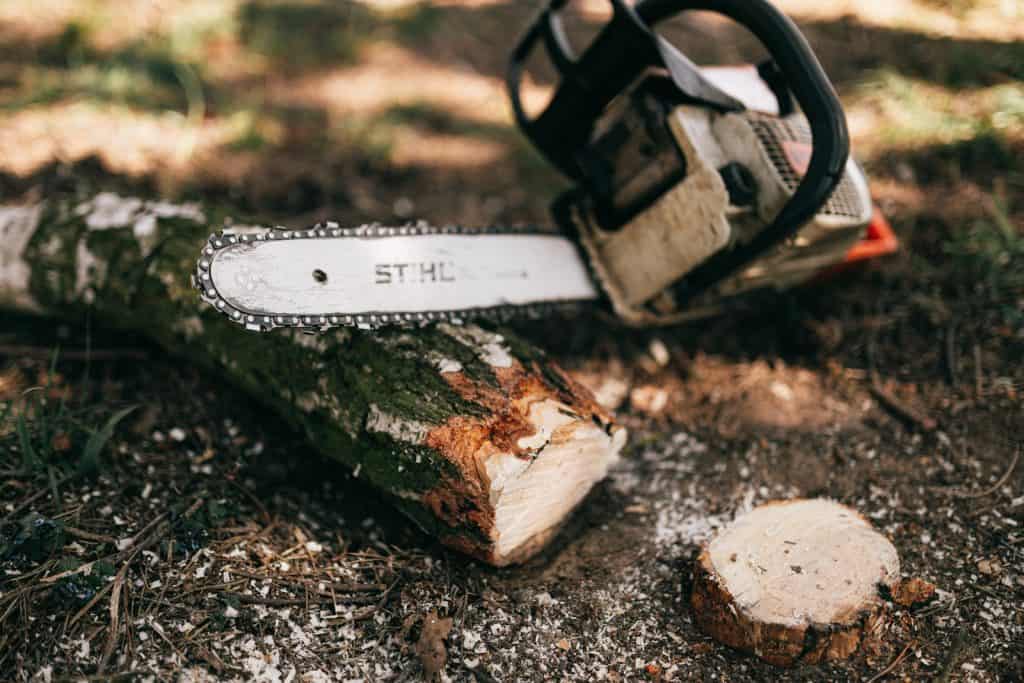Chainsaws are excellent tools that can be used almost anywhere for your cutting projects. While this portability is convenient, you still need to be aware of environments that limit the productivity of your chainsaw, as well as the durability and function. Using your chainsaw in the dirt is one area you should avoid to keep your equipment in ideal working condition.
It is recommended to avoid using a chainsaw in the dirt to prevent the blade from dulling with flying debris, prevent the chains from wearing out or losing lubrication, and avoid dirt from entering the motor. All of these preventative measures will extend the life of a chainsaw and keep parts from needing to be replaced prematurely.
Especially when cutting through large pieces of material, the force you apply to the wood can easily hit the ground once the pieces have split. If the dirt is the contact surface, the rotating mechanisms can be damaged as dirt can easily make its way into small crevices along the chain. Practicing safe chainsaw technique in dirtless areas is the best way to operate your tool.
Can You Use a Chainsaw in the Dirt?

While using a chainsaw in the dirt will not guarantee damage upon initial contact in every cutting session, the risk of damage because of consistent exposure should prevent you from using it in these conditions. The risk comes with cutting through the wood and then hitting the chainsaw into the ground with force.
Because using a chainsaw also kicks up surrounding debris, operating close to the dirt without touching can damage the equipment as well. If you are going to be operating around dirt, you should prop the wood up on supports that keep the saw from slipping. (Source: Family Handyman)
Lifting workpieces off the ground will keep the chainsaw in good condition when you cut all the way through. This prevents any contact with the ground. Make sure that all chainsaw cutting is done away from your body to prevent injury. When the chainsaw has nothing left to cut, the power and momentum may continue to lunge it forward in the direction you were cutting.
Standard chainsaws are designed to cut through wood and should not be exposed to dirt. Models that are designed to cut through stone and rocks limit the risk of dirt damaging your saw, but it is always best to avoid small rocks and sand when possible.
Why Shouldn’t You Use a Chainsaw in Dirt?

Damage to a chainsaw with dirt can lead to multiple functional and performance issues. Dirt (also referred to as soil in many cases) is a combination of sand, silt, clay, and organic matter. (Source: Nature Education) The sand and small rock particles in the dirt are the cause of most damage as they can be caught or scratch the metal surfaces of the moving chainsaw parts.
The primary problems with operating a chainsaw in the dirt include:
- Dull blade/cutters: While chainsaw blades will eventually dull and need to be sharpened, using them in the dirt leads to premature sharpening. Sharp chainsaw blades (or teeth) are necessary for clean and effective cutting. (Source: Stihl) You will notice that the blade is dulling when the saw must use force to cut, sawdust is produced rather than chips, excessive smoking, or when there is bouncing in a cut.
- Worn or stuck chains: Chainsaws are designed to move a link of cutters around a guide bar for cutting. (Source: How Stuff Works) This process is completed by smoothly carrying the lubricated chain at speed to create a sharp surface. If there is sand trapped in the chain or covering the lubricated surface, it cannot function properly. This may prevent the chain from running at all or doing so efficiently.
- Motor and sprocket damage: The sprocket on the chainsaw is connected to the motor and provides the driving power for the chain to rotate around the guide bar. (Source: Science Channel) The functionality of the sprocket is crucial in allowing the motor to function and connect its power to the chain itself fully. If dirt is trapped in the sprocket or gets into the motor, it may make the chainsaw lose functionality or underperform.
Because chainsaws will dull over time and lose lubrication with extended use in any environment, avoiding the dirt keeps this from happening before replacement or sharpening is required. While using a chainsaw in the dirt may be convenient at the time of cutting, it will likely lead to more significant equipment problems that are both time consuming and costly.
How to Cut with a Chainsaw Safely Near Dirt
There may be some situations where cutting with a chainsaw in the dirt is unavoidable. The primary goal is to prevent the chainsaw from cutting through and making contact with the surface. There are multiple strategies in which you can make a cut and prevent this extra drive and contact from occurring.
If the wood is too large or heavy to prop up, using other tools to accompany your chainsaw and monitoring your cut can save your chainsaw and get the job done.
The following approaches are recommended when cutting with a chainsaw on or near dirt:
- Cut 90% of wood: Carefully cut through the wood with your chainsaw until you have made it about 90% of the way through. At this point, rotate the log to the uncut side. You can use an axe or the force of your foot to break the remaining portion. Axes will be more beneficial with larger pieces of wood, while your foot should be reserved for the quick force needed for thinner logs. This kick method is effective on pieces with a short side but take care to wear proper shoes and protective equipment.
- Wipe the wood: If you do need to flip the log over, make sure you clear the side that was touching the dirt surface. A broom should be sufficient to clear the debris. This is important to limit any contact with the small pieces of sand.
- Use a log jack: A log jack is a tool that is designed to lift the wood off the ground to prevent contact with the dirt and surface below. The tool wraps itself around the surface of the log and uses a long handle with a stand on the bottom to lift the log with force. The log will rest on the stand and allow for clean cuts. You can check out an example of how to use one below!
It may be inevitable that you will need to cut wood near or in the dirt. Applying these alternative methods will keep your chainsaw in the best condition given the environment.
Don’t Forget to Protect Yourself, Too!
Whenever you are operating a chainsaw, regardless of the environment, you should be wearing proper protective equipment. This includes supportive and closed-toed shoes, long protective pants, long sleeves, gloves, a helmet with eye protection, and ear protection. (Source: Husqvarna) With flying debris, sharp tools, and loud noises, being fully covered is crucial.
Especially for those who operate chainsaws frequently, protecting your eyes, ears, and skin is imperative. When in the dirt with dusty conditions, having all necessary protection should be made the top priority in the event the chainsaw slips or malfunctions.
In Conclusion
Protect yourself and the chainsaw by operating the machine safely and out of the dirt! Not only does your chainsaw last longer when used carefully and as intended, but it will also save you lots of money on unnecessary repairs.
Related Posts:
Can You Use a Chainsaw Without Bar Oil?
Sharpening Your Chainsaw In The Field
10 Types of Chainsaw Chains Explained

